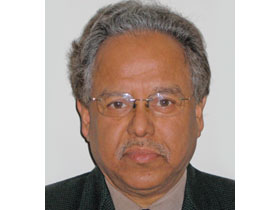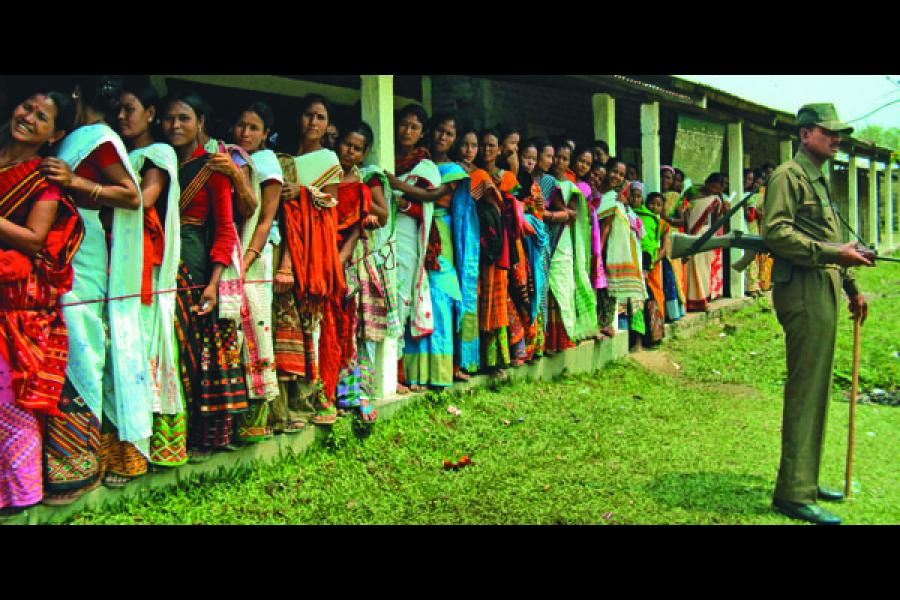
Assam, Don't Hold Your Breath
In spite of successful elections, it's too early to declare that the troubled state is on the road to recovery
There are signs that the Assam elections mark the beginning of a new phase in the state’s politics. The voter turnout rate of 76.03 percent was impressive and the United Liberation Front of Assam (ULFA) did not call for a poll boycott. While the familiar controversy over the citizenship status featured in the campaign, especially in the BJP platform, it was not a defining element as it was in 2006, or arguably, in all state elections since the beginning of the Assam Movement of 1979-85.
Is this the end of Assam’s troubles and the inauguration of the politics of good governance and development? Unfortunately, such a reading would be premature, and it would be a triumph of hope over reality.
Politicians often respond to problems with words rather than deeds, or by symbolic rather than instrumental actions. That buys time, but ultimately, rhetoric cannot be a substitute to solutions. And the problems underlying Assam’s political troubles are neither minor, nor provincial. They raise fundamental questions about the Partition’s vision of two, and subsequently three, bounded nation-states, and whether it matches the subcontinent’s subsequent ground realities.
 During the Assam Movement of 1979-85, the campaigners claimed that tens of thousands of “foreigners” were enfranchised in Assam. This is hardly an issue that can be settled in any obvious way. Thus, when the Supreme Court in 2005 — 20 years after the end of the Assam Movement — found the Illegal Migrants (Determination by Tribunals) Act to be unconstitutional, its ruling read almost like an official text of the Assam Movement. There can be “no manner of doubt,” said the court that Assam is facing “external aggression and internal disturbance” because of large-scale illegal immigration from Bangladesh.
During the Assam Movement of 1979-85, the campaigners claimed that tens of thousands of “foreigners” were enfranchised in Assam. This is hardly an issue that can be settled in any obvious way. Thus, when the Supreme Court in 2005 — 20 years after the end of the Assam Movement — found the Illegal Migrants (Determination by Tribunals) Act to be unconstitutional, its ruling read almost like an official text of the Assam Movement. There can be “no manner of doubt,” said the court that Assam is facing “external aggression and internal disturbance” because of large-scale illegal immigration from Bangladesh. Second, our citizenship laws take little cognizance of the post-Partition cross-border population flows, except those that occurred during the immediate years after the Partition. Indian citizenship laws embody the spirit of the Nehru-Liaquat pact of 1950 that sought to maintain a population status quo. Thus, there is no way in Indian law to make a distinction between Hindu and Muslim arrivals from Pakistan or Bangladesh except in the context of the immediate post-Partition years; and that too only by implication. But there is a tension between the legal definition of Indian citizenship laws, and the fact that many Indians believe that Hindus have an implicit right of return to post-Partition India.
Third, we have been able to live with these ambiguities because our citizenship practices enable a blurring of the line between citizens and non-citizens. In particular because the documentation that enables a person to be included in the electoral roll in India can be rather rudimentary including say, a ration card.
In the words of the Japanese scholar Hiroshi Sato, there are fault lines between the normative definition of citizenship in Indian law, and the actual exercise of franchise by people “based on the legitimacy of rudimentary documents rather than on the registration of citizenship.” It is hardly surprising that by bringing the issue to the centre stage of Assam politics, the campaigners of the Assam Movement set in motion a virtual earthquake and multiple aftershocks in the state’s political landscape.
ULFA was founded in 1979. Even though the citizenship issue has never been directly on ULFA’s agenda, it views the gradual political marginalisation of locals, because of immigration and the enfranchisement of non-citizens, as a symptom of Assam’s subordinate political status in the
pan-Indian dispensation.
ULFA as an idea has always been more powerful than the reality of ULFA as a political organisation. Unlike our security experts, politicians like Tarun Gogoi intuitively understand it. This has led to attentiveness to questions such as the dignity of ULFA chairman Arabinda Rajkhowa since his arrest. That the election season included a meeting between the ULFA leaders and the Prime Minister is hardly accidental. However, it is difficult to imagine a solution of the “ULFA problem” within existing policy parameters.
Words that appear in ULFA’s vocabulary, whether “sovereignty” or “full regional autonomy”, essentially invoke ideas of serious constitutional reforms including for instance, the radical expansion of the powers of the state legislature to include powers over questions of citizenship. It is not hard to see why ULFA would want to talk of such reforms. Nor are such arrangements unheard of in the world of federations. But it is hard to square them with the repertoire of political solutions to Northeast India’s “insurgencies” available among our officials that go little beyond the idea of an ethnic peace accord.
(Sanjib Baruah teaches political science at Bard College in New York. His books include India against Itself: Assam and the Politics of Nationality)
(This story appears in the 06 May, 2011 issue of Forbes India. To visit our Archives, click here.)
-
 Himraj
HimrajNot only the supreme court but also past governors of Assam like Lieutenant General S.K. Sinha has raised this nth number of times, but to be frank Politicians will be politicians...they have got a very short term vision of whatever they do and kept on ignoring this. But surely time is not in their side nor in India's side...the dice is already rolled and it's just a matter of time that entire NE will be in the hands of Bangladesh. If Indian politicians are really interested in resolving this and want that not only Assam but entire NE needs to be remain within India. They should let Assam be ruled under governors for at least 10 years and let the Governor do their duty of cleaning up the or else let NE say good bye to India and welcome to Bangladesh.......(.please check this http://en.wikipedia.org/wiki/Greater_Bangladesh...)
on May 3, 2011















